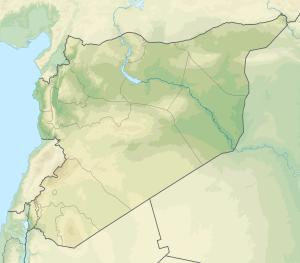 Global Information
Global InformationTell Fekheriye information
تل الفخيرية | |
Tell Fekheriye, Syria | |
 Tell Fekheriye Shown within Syria | |
| Alternative name | Sikkan |
|---|---|
| Location | Ras al-Ayn, Al-Hasakah Governorate, Syria |
| Region | Upper Mesopotamia |
| Coordinates | 36°50′24″N 40°4′7″E / 36.84000°N 40.06861°E |
| Type | Settlement |
| Site notes | |
| Excavation dates | 1929, 1940, 1955, 2001, 2006-2010 |
| Archaeologists | Felix Langenegger, Hans Lehmann, Calvin W. McEwan, A. Pruß, Anton Moortgat |
| Condition | In ruins |


Exhibited in the Oriental Institute Museum, Chicago, USA.
Tell Fekheriye (Arabic: تل الفخيرية) (often spelled as Tell el-Fakhariya or Tell Fecheriye, among other variants) is an ancient site in the Khabur river basin in al-Hasakah Governorate of northern Syria.[1] It is securely identified as the site of Sikkan, attested since c. 2000 BC.[2] While under an Assyrian governor c. 1000 BC it was called Sikani.[3][4] Sikkan was part of the Syro-Hittite state of Bit Bahiani in the early 1st millennium BC. In the area, several mounds, called tells, can be found in close proximity: Tell Fekheriye, Ras al-Ayn, and 2.5 kilometers east of Tell Halaf, site of the Aramean and Neo-Assyrian city of Guzana. During the excavation, the Tell Fekheriye bilingual inscription was discovered at the site, which provides the source of information about Hadad-yith'i.[5]
In the early 20th century Tell Fekheriye was suggested as the site of Washukanni, the capital of Mitanni, but the claim is unconfirmed.[6][7] Many scholars opposed this theory including Michael Roaf, Peter Akkermans, David Oates, Joan Oates and Edward Lipiński.[2][8][9] However this identification received a new support by Stefano de Martino due to recent archaeological excavations by a German team led by Mirko Novák and Dominik Bonatz.[10]
- ^ L. Braidwood, Stone artifacts in C McEwan, Soundings at Tell Fakhariyah(Chicargo University Press, 1958 page 53-55.
- ^ a b Lipiński, Edward (2000). The Aramaeans: Their Ancient History, Culture, Religion. Peeters Publishers. p. 120. ISBN 978-90-429-0859-8.
- ^ Postgate, J. N. “The Land of Assur and the Yoke of Assur.” World Archaeology, vol. 23, no. 3, 1992
- ^ Gropp, Douglas M., and Theodore J. Lewis. “Notes on Some Problems in the Aramaic Text of the Hadd-Yithʿi Bilingual.” Bulletin of the American Schools of Oriental Research, no. 259, 1985, pp. 45–61
- ^ Dušek, Jan and Mynářová, Jana. "Tell Fekheriye Inscription: A Process of Authority on the Edge of the Assyrian Empire", The Process of Authority: The Dynamics in Transmission and Reception of Canonical Texts, edited by Jan Dušek and Jan Roskovec, Berlin, Boston: De Gruyter, pp. 9-40, 2016
- ^ K. Lawson Younger (2007). Ugarit at Seventy-Five. p. 146. ISBN 9781575061436.
- ^ Edward, Lipiński (2016). "Hurrians and Their Gods in Canaan". Rocznik Orientalistyczny/Yearbook of Oriental Studies.
- ^ D. T. Potts (2012). A Companion to the Archaeology of the Ancient Near East. p. 570. ISBN 9781444360776.
- ^ David Oates; Joan Oates; Helen McDonald (1997). Excavations at Tell Brak, Volume 1. p. 143. ISBN 9780951942055.
- ^ De Martino, Stefano, 2018. "Political and Cultural Relations between the Kingdom of Mittani and its Subordinated Polities in Syria and Southeast Anatolia", in Changing Faces of Kingship in Syria-Palestine 1500-500 BCE, Ugarit Verlag, p. 38: "...the recent German archaeological excavations at Tell Fekheriye support the assumption that the capital of Mittani, Wassukkanni, was located there..." See also Novák (2013: 346) and Bonatz (2014).